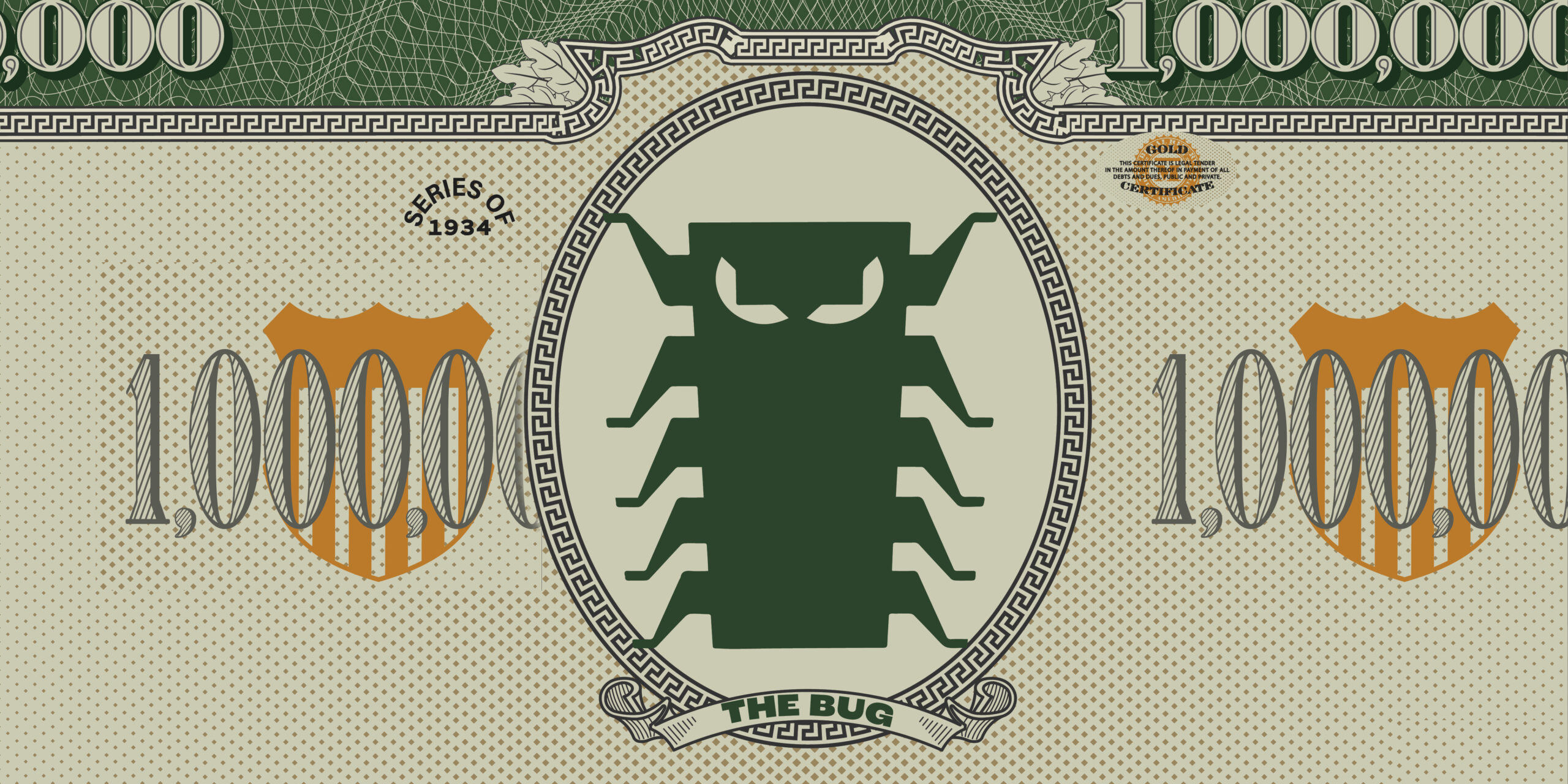Marc Ambasna-Jones explores mafia killers, K-pop and woodland bunkers to find the truth about the Y2K bug and some pretty big bucks.
In the late 1990s the millennium bug went viral before social media even existed. It triggered enough fear across the globe that governments and businesses spent billions. But when nothing really happened, the accusations against software vendors began.
In the days leading up to New Year’s Eve in 1999, the Italian government was taking a bit of stick for not acting quickly enough, or at least, not spending enough, to address the millennium bug. One CBS report on December 26th suggested a common reaction from Italians was a perhaps stereotypically relaxed ‘who cares?’. But while the majority of other countries had already spent billions on so-called fixes for the Y2K problem, Italy seemed to have had the last laugh. When the clock struck midnight and computer dates moved from 99 to 00, nothing really happened. Planes didn’t fall out of the sky and there was no infrastructure meltdown – although one Italian court clerk did discover that four convicted mafia killers should have been released 100 years earlier on January 10, 1900.
In the aftermath of Y2K, some problems did materialise. Cash registers at convenience store chain 7-Eleven went belly up, for example, although this wasn’t down to the millennium bug but because programmers that ‘fixed’ Y2K forgot the year 2000 was a leap year. There were reports of other issues on the days that followed, but to get a real sense of the hype and fear as midnight approached, you only have to remember the BBC’s real-time ‘bug watch’ coverage.
The lack of drama come midnight did prompt questions as to whether or not the whole thing had been an elaborate hoax by the software industry. Given that global spend on Y2K fixes were estimated to have been in the region of $300-600bn (some estimates put it even higher), it’s easy to see why. There were already rumblings of discontent at the money spent and the lack of real evidence for doomsday. Stories, such as the one where the US Navy put all its computer clocks forward only for everything to carry on as normal, didn’t really help.
For some, all of this hadn’t come as a big surprise. On December 11, 1999, Ross Anderson, Professor of security engineering at Cambridge University and Edinburgh University, published a paper titled ‘The Millennium Bug – Reasons not to panic’. It was the results of his department’s own experiments in measuring the potential effects of a 00 date change. The conclusion was that ‘had we done nothing at all about Y2K, we would not have been much worse off than we are now,’ wrote Anderson in the paper.
“I’d realised by the start of 1999 that the risks were greatly exaggerated, but the hype was still going strong and the vendors were doing great business off the back of it,” says Anderson reflecting on the build-up to the new millennium. “I wondered when the best time would be to offer some reassurance and reckoned it would be later in the year. I did my best but the media basically weren’t interested. ‘World not about to end’ isn’t a story. Afterwards, I faced some real anger from CIO types who said that if they hadn’t spent millions fixing the bug, their company would have failed.”

The hype was going strong and the vendors were doing great business off the back of it – Ross Anderson, Cambridge University
Anderson, who first became aware of the possible disruption of the millennium data problem back in 1986, admits that the possibility of the glitch causing chaos and civil unrest was a factor in his decision, ten years later, to buy a secluded house in the country with a wood burning stove and well. The fact is, Anderson was never dismissive of the Y2K problem; he just wanted clarity and for governments and businesses to have some perspective.
“While lots of things may break, few of them will matter much,” he concluded in his paper. “Many of the concerns we had last year about the millennium bug turned out to be misplaced once we examined the relevant systems in detail. I am now pretty confident that the British government’s concerns about small to medium sized businesses are mostly groundless.”
The British government at the time, like many governments around the world, was taking it very seriously. Its Action 2000 task force, set up to monitor readiness for Y2K, pumped out a series of black-and-white public information films to try and get everyone, primarily small and medium sized enterprises, to also take it seriously. It had also started naming and shaming local authorities as the pressure mounted. Ian Hugo, a UK technologist who wrote the UK’s Y2K standards, even suggested, on Sunday January 2nd 2000, that the remedial work had been a big success.
“Throughout the world I think you’ll find that almost a trillion dollars was spent on Y2K work. There ought to be some results,” he said.
It was the same Ian Hugo that Julian Tanner, managing partner at tech PR firm Tuva Partners, managed to annoy at a conference in 2001, when during a talk he suggested Y2K was a fraud perpetrated by the IT industry. In the 90s and the noughties, Tanner worked as co-founder of tech PR firm AxiCom with some big names that operated in the Y2K space.
“All IT vendors fed voraciously off the fear that the Y2K bug engendered among customers, but coming towards the date they split into two camps; there were those like IBM that pulled back from even mentioning Y2K in the final six months for fear that they might be sued by angry customers when it turned out to be nonsense. Then there were those like France’s Groupe Bull that drank the Kool-Aid and even held a vigil on the eve of Y2K,” says Tanner.

IBM pulled back from even mentioning Y2K in the final six months for fear that they might be sued by angry customers –
Julian Tanner, Tuva Partners
“There were companies set up like Italian software firm HAL that did nothing but Y2K preparedness, and who made millions out of the paranoia that the IT industry had created. When nothing happened on the 1st January 2000, it was extraordinary how quickly they disappeared or pivoted to new markets.
“Even after Y2K had come and gone with barely a problem globally, the people who had been behind the furore and heading up the Y2K task forces still insisted that it had all been true and that only the state of preparedness had stopped a calamity. Thank goodness for Italy that did absolutely nothing to prepare for Y2K and so showed the world that the whole thing had been a very expensive farce.”
The idea that big software companies and consultants were profiting from the hype and fear-mongering of Y2K started well before the year 2000. As CNET suggested in a 1997 article titled ‘Profiting from the Year 2000 Bug’, ‘the upside, if you believe Wall Street, is that the so-called millennium bug will be a moneymaking opportunity for a handful of software makers and consulting firms’.
The article also refers to an IDC study claiming it ‘expects the high-tech market to benefit from extra spending on Y2K-related problems, which may continue throughout the year. Existing information technology budgets are being exhausted, and additional cash from other areas is being shifted toward dealing with problems associated with the year 2000 changeover’.
Of course, money was spent. Y2K was a real problem, after all. For Tom Cheesewright, applied futurist and author of ‘Future-proof Your Business’, the lack of post-year 2000 incidents justifies the actions that were taken.
“I’d say that the Y2K experience is a pretty good advert for foresight,” he says. “We looked at the possible outcomes well in advance and most people worked to avert the threat or made contingencies. As a result, the problem was minimal.

Around the world thousands of systems were affected by Y2K, from spy satellites, to banking systems, to nuclear reactors –
Tom Cheesewright, Book of the Future
“While we remember it now as largely a non-event, around the world thousands of systems were affected by Y2K, from spy satellites, to banking systems, to nuclear reactors. While the scale of the issue was minimised, lots of individuals were – at best – inconvenienced.”
An article published in 2013 by Brightwork Research was a little more accusatory of the role of software vendors. The report, ‘How the Y2K issue was deliberately exaggerated by ERP vendors’, was written by Shaun Snapp, a former SAP consultant and supply chain specialist.
“Before 2000, a relatively minor issue concerning addressing a coding oversight was blown into a full-bore crisis by entities with software and consulting services to sell,” says Snapp in a video clip.
A lot of what Snapp claims is believable but it’s not necessarily new. He suggests Y2K was a simple fix blown out of all proportion, and in some cases he may be right. But as a New Scientist article pointed out two years ago, ‘an estimated 80 percent of computers fixed in 1999 used the quicker, cheaper option,’ in a process referred to as ‘windowing’. This was essentially a patch, something which Dr Dylan Mulvin at the London School of Economics suggested was “the worst of all possible solutions because it kicked the problem down the road”.
The big money though, was in the large transformations. BT alone was reported to have spent around £300m on the Y2K glitch. Speaking to InfoWorld in 2010, David Quinn, who ran the systems software group at BT, said that while around 70 percent of the concerns about Y2K turned out to be unfounded, BT couldn’t take a chance on it. Mission critical services needed to be sure nothing would go wrong. So, in that sense, the conditions were perfect for overt capitalism to spread its wings. Industries have always taken advantage where they can, especially during a time when, for many organisations, technology was still very new and relied heavily upon outsourced expert opinion. For Steve Ingram, director at Deloitte UK, it was this “naivety” that really led to the panic and uncertainty.
“Nobody really knew for sure what would happen,” he explains. “Given the uncertainty, the chance something might happen, it was probably a right call to action change and amend systems. But then it became a headline writer’s dream and that’s when all the conspiracy theorists got into it.”

It became a headline writer’s dream and that’s when all the conspiracy theorists got into it – Steve Ingram, Deloitte
Ingram agrees the Y2K scare created an industry in itself at the time. It was a perfect storm, with so many organisations and government departments investing in new software systems and patching old mainframes. Some saw it as an opportunity to modernise, but in those days migrations to new technologies took years, not months. As such, software vendors and consultants were needed more than ever before, and budgets were being created to address Y2K as a matter of urgency, especially throughout 1999.
“You could charge a premium for the software and you could charge a premium for the services, as long as you hit the date,” admits Ingram.
The turnover figures for ERP vendors at this time were astounding. Oracle saw a 22 percent growth in revenue ($2.9bn) in a record fourth quarter, while SAP also saw record profits. But in the two years following the new millennium, ERP vendors were struggling. There was transition to the internet age, new competition and increasing interest in integrated ERP, customer relationship management and supply chain management solutions. This was no longer boom time for traditional ERP, and as one report suggested, some vendors were still blaming the Y2K bug for poor financials. Such is the ebb and flow of the constantly disrupting tech industry.
In the days that followed New Year’s Day 2000, some media outlets did try to address the cost issue and whether or not it was all worth it. The horse had already bolted by then, of course. But writing in The Guardian, the then-tech editor Jack Schofield quoted Bruce McConnell, from the UN-backed organisation IY2KCC that tracked Y2K progress, on the true costs of Y2K.
“I don’t think anybody knows – or will ever know,” said McConnell.
The legend of Y2K, however, never seems to go away. There’s still enough doubt and intrigue to keep the doubters and theorists busy, and now there is suggestion of a new problem on the horizon. In 2014, South Korean pop star PSY shot to global fame with the hit song ‘Gangnam Style’. The video broke YouTube as the site, like so many others, was built using a 32-bit system. This essentially meant that there was a threshold and PSY’s rodeo-style dance moves hit the ceiling. The view count stood at 2,147,483,647.
The Metro newspaper ran a headline. ‘All computers are going to be wiped out in 2038… and YouTube’s Gangnam Style problem may prove it’. No doubt the sort of headline to irk Professor Anderson at Cambridge University, but while sensationalising computer glitches sells newspapers – or gets clicks – this doomsday scenario has yet to really take hold. Is there any real truth in it? Surely 32-bit systems will be a thing of the past by 2038?
“There’s a lot of old software out there, not all of it well written, or maintained,” says Cheesewright. “Just like Y2K, inevitably some will slip through any checks.” The futurist though admits that he has yet to come across the issue and clients have not raised any concerns.
What have we learned from all of this? To be more sceptical, perhaps? To keep up to date with software upgrades? To not leave everything to the last minute? To always have a back up plan, a log cabin with a generator and a larder full of tinned food? Whatever the lesson, it’s clear that software vendors and consultants cleaned-up with Y2K, some in the knowledge perhaps that they were over-egging it a bit, and others with, well, maybe a bit more altruism.
So many years after the event, it’s difficult to know for sure. But one thing is certain: it won’t be the last time software vendors jump on a bandwagon and try to squeeze IT budgets into submission.




